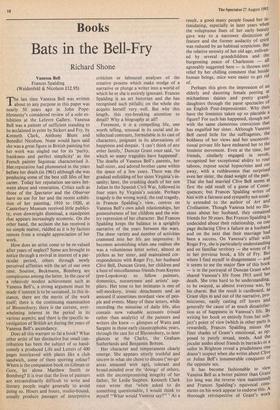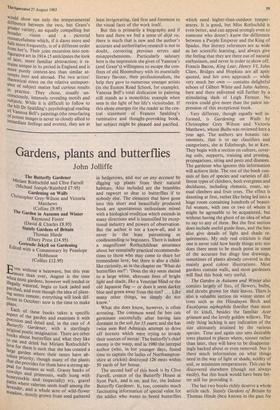Books
Bats in the Bell-Fry
Richard Shone
Vanessa Bell Frances Spalding (Weidenfeld & Nicolson £12.95)
The last time Vanessa Bell was written about to any purpose in this paper was nearly 50 years ago in John Pope- Hennessy's considered review of a solo ex- hibition at the Lefevre Gallery. Vanessa Bell was a painter of sufficient standing to be acclaimed in print by Sickert and Fry, by Kenneth Clark, Anthony Blunt and Benedict Nicolson. None would have said she was a great figure in British painting but her work was singled out for its 'purity, frankness and perfect simplicity' as the French painter Segonzac characterised it. Her reputation had plummeted in the years before her death (in 1961) although she was producing some of the best still lifes of her career. Today her reputation see-saws bet- ween abuse and veneration. Critics such as those of the Spectator and the Observer have no use for her and the recent exhibi- tion of her painting, 1910 to 1920, at Canterbury Museum received little publici- ty, even downright dismissal, a standpoint that appears increasingly eccentric. On the other hand, the acclaim she has received is no simple matter, riddled as it is by factors remote from a straight appreciation of her work.
How does an artist come to be re-valued after years of neglect? Some are brought to notice through a revival in interest of a par- ticular period, others through newly perceived affinities with the art of our own time. Soutine, Beckmann, Bomberg are conspicuous among the latter. In the case of a relatively modest achievement such as Vanessa Bell's, a strong argument must be made if interest is to be sustained. In this in- stance, there are the merits of the work itself; there is the continuing examination of Bloomsbury; there is the current, over- whelming interest in the period in its various aspects; and there is the specific in- vestigation of British art during the years of Vanessa Bell's ascendancy.
Does all this warrant so fat a book? What other artist of her distinctive but small con- tribution has been the subject of so hand- somely a produced Life and Letters of 400 pages interleaved with plates like a club sandwich, some of them sporting colour?
Where is the companion book on Gilman or Gore, let alone Matthew Smith or Bomberg? It is true that the lives of painters are extraordinarily difficult to write and literary people ought generally to avoid doing so. Hours and hours, studio-bound, usually produce passages of interpretive criticism or laboured analyses of the creative process which make stodge of a narrative or plunge a writer into a world of which he or she is entirely ignorant. Frances Spalding is an art historian and she has recognised such pitfalls; on the whole she acquits herself very well. But why this length, this eye-breaking attention to detail? Why a biography at all?
Foremost, it is a compelling life, one worth telling, unusual in its social and in- tellectual contrasts, formidable in its cast of characters, poignant in its alternations of happiness and despair. '1 can't think of any other family,' Duncan Grant once said, `to which so many tragedies have happened'. The deaths of Vanessa Bell's parents, her half-sister, and adored brother came within the space of a few years. There was the gradual unfolding of her sister Virginia's in- sanity; later, the crushing death of her son Julian in the Spanish Civil War, followed in four years by Virginia's suicide. Perhaps tragedy is the wrong word; the real tragedy, in Frances Spalding's view, centres on Vanessa Bell's own adult relationships, her possessiveness of her children and the win- try repression of her character. But Frances Spalding keeps the balance in a sprightly narrative of the years between the wars. The sheer variety and number of activities crammed into her life are impressive. It becomes astonishing when one realises she was a voluminous letter writer, almost as pitiless as her sister, and maintained cor- respondences with Roger Fry, her husband Clive Bell, Duncan Grant, her children and a host of miscellaneous friends from Keynes (pre-Lopokova) to fellow painters, domestics, nurserymen and artists' sup- pliers. Her tone to her intimates is one of self-mockery, ironic detachment and an amused if sometimes mordant view of peo- ple and events. Many of these letters, while recording the minutiae of daily life, also contain now valuable accounts (visual rather than analytic) of the painters and writers she knew — glimpses of Watts and Sargent in those early claustrophobic years, through the cast list of Bloomsbury, to later glances at the Clarks, the Graham Sutherlands and Benjamin Britten.
Her character and temperament clearly emerge. She appears utterly truthful and sincere in what she chose to discuss (` no-go' areas amassed with age), tolerant and broad-minded over the 'doings' of others, with the uncompromising integrity of her father, Sir Leslie Stephen. Kenneth Clark once wrote that 'when asked to do something questionable, I would think to myself "What would Vanessa say?" ' As a
result, a good many people found her in- timidating, especially in later years when the voluptuous lines of her early beauty gave way to a narrower distinction of feature and the former audacity of spirit was reduced by an habitual scepticism. But the relative serenity of her old age, enliven- ed by several grandchildren and the burgeoning peace of Charleston — all agreeably suggested here — is thrown into relief by her chilling comment that beside human beings, mice were easier to get rid of.
Perhaps this gives the impression of an elderly and daunting female peering at michaelmas daisies and pretty grand- daughters through the passé spectacles of an English Post-Impressionist. Why then have the feminists taken up so placable a figure? For such has happened, though not with the same clamorous conviction that has engulfed her sister. Although Vanessa Bell cared little for the suffragettes, the boldness of her views and her unconven- tional private life have endeared her to the feminist movement. Even at the time, her friends, similarly engaged in revolt, recognised her exceptional ability to rout taboos, expose social hypocrisies and cut away, with a ruthlessness that surprised even her sister, the dead weight of the past. That she had married Clive Bell seems at first the odd result of a game of Conse- quences; but Frances Spalding writes of him with a fairness and sympathy not usual- ly extended to the author of Art and Civilisation. Though Vanessa held no illu- sions about her husband, they remained friends for 50 years. But Frances Spalding is undecided about their relationship, on one page declaring Clive a failure as a husband and on the next that their marriage had been a success. On Vanessa's affair with Roger Fry, she is particularly understanding and on familiar territory — she wrote of it in her previous book, a life of Fry. But where I find myself in disagreement — and it seems to me the major flaw of this book — is in the portrayal of Duncan Grant who shared Vanessa's life from 1915 until her death. She tries hard to be understanding, to be swayed, as almost everyone was, by his charm. But the result is cardboard, as Grant slips in and out of the narrative, pro- miscuous, easily casting off lovers and generally the cause of as much dissatisfac- tion as of happiness in Vanessa's life. BY writing her book so entirely from her sub- ject's point of view (which in other parts is rewarded), Frances Spalding misses the finer shades of Grant's emotional, as 0P- posed to purely sexpal, needs. And the jocular asides about friends in barracks or a sailor in Brighton reveal a prudishness one doesn't suspect when she writes about Clive or Julian Bell's innumerable conquests of the opposite sex. It has become fashionable to view. Vanessa Bell as a better painter than Grant (so long was the reverse view maintained) and Frances Spalding's equivocal com- ments on his work appear to endorse this. A thorough retrospective of Grant's work would show not only the temperamental difference between the two, but Grant's greater variety, an equally compelling but broader vision and a pictorial resourcefulness which, if it dares more and fails more frequently, is of a different order from her's. Their joint excursion into non- figurative art in 1914-15 anticipates the look of later, more familiar abstraction; it re- mains unique in its period in England and is more purely content-less than similar at- tempts here and abroad. The two artists' theoretical stress on the relative unimport- ance of subject matter had curious results to practice. They chose, usually un- consciously, intensely revealing motifs and subjects. While it is difficult to follow to the hilt Dr Spalding's psychological reading of Vanessa Bell's paintings (the resurfacing of potent images is never so closely allied to immediate feelings and events), they are at
least invigorating, tied first and foremost to the visual facts of the work itself.
But this is primarily a biography and if here and there we feel a sense of déjà vu, there is much that is new and the author's accurate and authoritative research is not in doubt, correcting previous errors and misapprehensions. Particularly salutary here is the impression she gives of Vanessa's (and Grant's) willingness to escape the con- fines of old Bloomsbury with its essentially literary flavour, their professionalism, the help they gave to numerous younger artists (in the Euston Road School, for example). Vanessa Bell's total dedication to painting still stands as a monolithic example when seen in the light of her life's vicissitudes. If this alone emerges for the reader as the cen- tral statement of Frances Spalding's ruminative and thought-provoking book, her subject might be pleased and pacified.



































 Previous page
Previous page